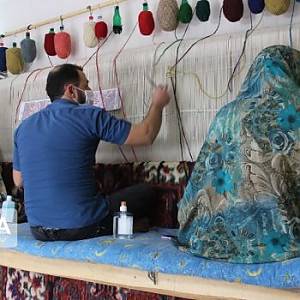A considerable portion of the material manifestations of Iran’s living heritage is bound within limited social groups, mostly at the family or small workshop levels, and these seem to be relatively unaffected by COVID-19.
At the family level, one witnesses family craftsmanship workshops for carpet-weaving, traditional embroidery, wood-work, jewellery making, pottery, etc. Many Iranian artists also work either individually or at the family level. These individual-, family- and workshop-based handicrafts and artistic outputs have a great potential to serve as a vital social and economic resource for these families and small businesses during the COVID-19 pandemic and in the post-virus recovery period.
However, it is important that their activities are supported by appropriate policies. For example, it is important to find alternative means of exhibiting and selling products, while cultural tours are non-existent and art fairs and craft festivals cannot take place in a physical sense.
An interesting aspect of this is the eagerness of a great number of older Iranian practitioners to continue to participate in transmission activities. The provision of equipment for virtual transmission (computers, internet access, required social media apps, etc.) will easily offer a basis for effective inter-generational transmission of stories, skills, traditional knowledge, oral traditions, performing arts, etc.
With proper financial support, this can also function as an income source for such elderly persons and, if they are recorded, such activities can contribute to the documentation and archiving of a considerable portion of Iran’s intangible heritage.
Architectural knowledge Many experts in the fields of architecture and urban planning have investigated architecture and the construction of Iranian houses in the past.
They consider that, for many reasons, the construction plans of old houses which are composed of a courtyard, pond, vestibule, warehouse, etc. are appropriate and efficient in the face of diseases, such as the one currently threatening the world. There is no doubt that past generations of Iranians had to find ways to live safely when diseases such as cholera and typhoid were rife and before effective treatments for these were found.
It is believed that such traditional preventive measures, including plans for houses could be revived as part of the post-COVID-19 response and moving towards a more resilient lifestyle.
For more details and for images of the element, see website
Las designaciones utilizadas y la presentación de los textos y documentos presentados en esta plataforma no suponen ninguna toma de posición por parte de la UNESCO acerca de la condición jurídica de los países, territorios, ciudades o zonas ni respecto al trazado de sus fronteras o límites.
